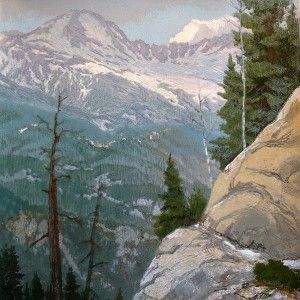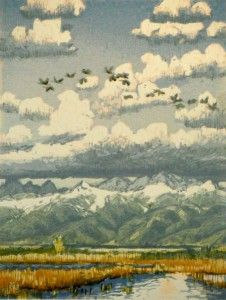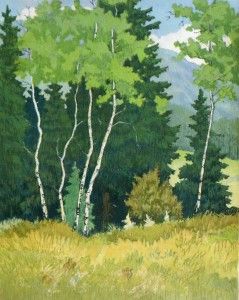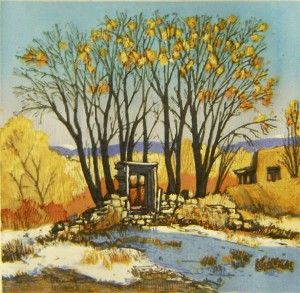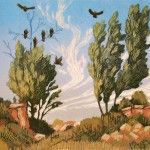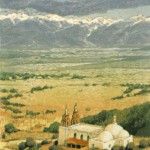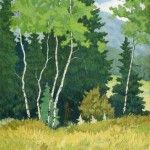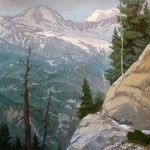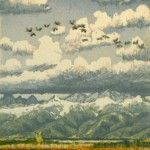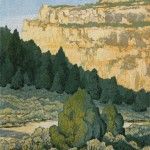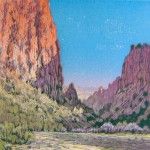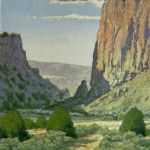Leon Loughridge carves out a sense of place in the West
By Bonnie Gangelhoff
Leon Loughridge’s fascination with art began early, and it began with his grandmother, Marjorie Mead Williams. As a youngster growing up in New Mexico, he recalls how Williams frequently held festive dinner parties and invited area artists from as far away as Denver. Her historic adobe home, constructed around 1880, featured works by artists such as Leon Gaspard. To this day, Loughridge recalls a Gaspard painting depicting a caravan of colorful carts and blanket-draped horses emerging from a forest—it hung in a prominent place in the living room. “It was magical,” the Colorado-based artist says.
Since Loughridge and his family lived in an adjoining house on the property, they were frequently invited to dine with the artists. “My brother and I would just sit and listen to the grown-ups talk about art,” Loughridge says. Well-known painters of the day, such as Pawel Kontny and Louis Ewing, were regular guests. Taos painter Joseph Imhoff frequently painted in a studio on the grounds of the ranch, which was perched in the dry Juniper Hills north of Santa Fe. When his grandmother wasn’t organizing artists’ gatherings, she took her grandsons to visit nearby galleries and also set up painting and drawing lessons for them. “After having so much exposure, art really started to click with me by the fourth or fifth grade,” Loughridge says.
Following high school graduation, Loughridge attended the Colorado Institute of Art (now known as the Art Institute of Colorado) for a brief spell. But the Vietnam War was raging, and he decided to enlist in the army rather than be drafted. He was stationed at a base outside of Stuttgart, Germany, where he provided logistics support and supplies to infantry units. After proving himself a tireless worker, he was allowed by a supportive commanding officer to take off one day a week if his assignments were completed.
Loughridge made good use of the privilege and soon became a regular at the local museums, including the Staatsgalerie Stuttgart, where he studied its incredible collection of Rembrandt etchings and Tiepolo drawings. He even copied a Frans Hals drawing for practice. “That all cemented my interest in printmaking. I bought a press in Germany and shipped it home,” Loughridge says. He arrived back in the United States in 1975, settled in Colorado, and immediately began his career in fine art, which has become his lifelong pursuit.
Today, when Loughridge, 59, isn’t out on location sketching mountains and valleys, he can be found in his studio—Dry Creek Art Press, which he opened 12 years ago in Denver. The cozy, 1,000-square-foot space is home to two printing presses—an antique press for large works and a Vandercook press for smaller ones. The studio walls are dotted with Loughridge’s colorful, framed woodblock prints. It’s a comfortable urban oasis near downtown. As this story was going to press, he was busily preparing works for two upcoming shows, including a solo exhibit in April at Mary Williams Fine Arts in Boulder, CO, that spotlights his watercolors depicting a recent Henry Moore exhibit at the Denver Botanic Gardens. On the small Vandercook press, Loughridge was also creating woodblock prints portraying New York City landmarks, such as the Flatiron Building and Central Park. These prints are destined for the American Masters show and sale in May at the legendary Salmagundi Club in New York.
But for the most part, Loughridge’s subject matter encompasses landscapes of the West and Southwest where he was born and raised. While he sometimes works in pastel and watercolor, he is best known for his woodblock prints and his signature method of layering colors to capture the beauty of the region. He brings an authentic sense of place to his works, which is achieved, in part, through his years of personal, familial, and cultural relationships to favorite locales, such as Colorado’s Fable Valley and Loveland Pass.
Indeed, Loughridge derives his inspiration directly from nature, much as a plein-air painter does. He regularly packs up his gear and ventures into the wild to create watercolor sketches. An intrepid outdoorsman, he relishes the challenge of painting on location despite changing or adverse climatic conditions. In freezing weather he carries a thermos of hot tea and packs colored pencils or pastels instead of watercolors for sketching. “When you are battling the elements, you don’t have time to think of all the wonderful things you want to convey,” he says. “It really comes down to effectively capturing the combination of light and color that seems so exciting. It is then that intuitive painting takes over.”
Over the years, Loughridge says, he has become attached to places such as Colorado’s San Luis Valley and has made frequent forays to view the sandhill cranes flying both north and south, depending on the season. In the spring he sees them streaking north across the sky, a scene he depicts in FLIGHT OF CRANES. He has heard the gargling sound of the birds and listened to them talk and call incessantly. When the cranes are in large, migratory groups, their calls are a cacophony that can be heard for some distance, Loughridge says. “They migrate through the flat sagebrush of the valley with the backdrop of the Sangre de Cristo Mountains. The surroundings are so big and dominant that I feel quite inconsequential,” he says. “I feel as if I am but a small moment in a dynamic environment that has seen the passage of cultures and civilizations.”
One of the most compelling elements of Loughridge’s work is his use of unexpected vantage points, whether he’s capturing a New York City building or a Rocky Mountain valley. In VEGA OVERLOOK, for example, the perspective is from high on a ridge looking down at a chapel nestled in the valley below. Loughridge explains that he is influenced by the works of Sir Lawrence Alma-Tadema (1836-1912), a Dutch-born, English classical painter who also was intrigued by unusual perspectives. “The horizon is always changing in his paintings,” Loughridge says. “The viewer can be looking down into a scene or up at a ceiling. I have learned a lot from him. I, too, am always trying to move viewers into an image, to give them interesting points of view, and share what affected me about a situation.”
For Loughridge, the unique perspectives, sights, sounds, smells, and weather conditions he experiences on location all go into creating an image that is more than just a rendering. While the act of sketching is the direct and invigorating encounter with the subject, creating the woodblock print and transforming it into a painterly image is about capturing the energy and spirit of that original sketch.
Once back in his studio from a plein-air excursion, Loughridge takes his watercolor sketch and traces it onto transparent paper using pen and ink. He next places a piece of carbon paper underneath the tracing- paper image and puts the two layers on top of a woodblock panel. Next he traces the image through both layers, transferring the drawing to the woodblock. Then, using sharp carving tools, he trims away any area on the woodblock that he wants to remain uncolored. What remains is the relief area that will be inked and printed. Loughridge applies his homemade colored ink using mini-rollers. “The rollers are my brushes,” he says.
The lightest color and the broadest area of the composition are printed first on each piece of paper that will make up the print run, or “edition.” Next, Loughridge carves away more material from the woodblock and prints the next color, a darker color than the first. The process continues with Loughridge carving away more and more of the block with each succeeding color run. The block is eventually destroyed, or “reduced,” in the process of creating the image, and because of this a woodblock print can never be reprinted.
The edition size is determined by how many acceptable impressions exist after the final color run. “Each print will consist of 15 to 20 color runs. It ends up being a lengthy procedure to create one image, but throughout the process I am always injecting a creative or intuitive approach,” Loughridge says. “I love the process of building the image. The printing process can be just as creative and intuitive as a plein-air painting.”
Indeed, the artist considers his prints successful only if the viewer experiences the same passion he felt while creating the original sketch and print. “There’s an absolute beauty in the West of big open spaces and skies. Maybe it’s because I’ve grown up and been outdoors all my life that I connect with the outdoors so much,” he says. “There’s a part of what happens out there on location that gives meaning to why and how I fit into the world. There is a real solace or comfort in being outdoors that removes all the clutter and hype of the world around me. To know that the passion of my original idea was translated into one of my prints is the artist’s reward.”
representation
Gerald Peters Gallery, Santa Fe, NM; Mary Williams Fine Arts, Boulder, CO; American Legacy Gallery, Kansas City, MO; Breckenridge Gallery, Breckenridge, CO; The Great Southwest, Colorado Springs, CO; Goodwin Fine Art, Denver, CO; Vail International Gallery, Vail, CO.






